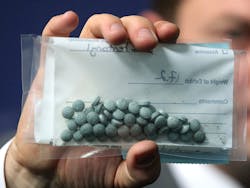DEA Warning to Law Enforcement: Fentanyl and Carfentanil Exposure Kills
Fentanyl, is a synthetic opiate, scheduled level II medication. It is considered an “Incapacitating Agent” by the CDC, and is solely used as a surgical anesthetic or as a narcotic to treat chronic, severe, or “breakthrough” cancer pain that cannot be controlled by other medications. It is the most potent opioid available for medical treatment. According to the CDC, pharmaceutical grade Fentanyl is estimated to be 80 times (8,000%) more potent than morphine and hundreds of times (20,000+%) more potent than heroin. Fentanyl is available in pills, a film that dissolves in the mouth, a transdermal patch which delivers the drug directly through the skin, and even lollipops. Prescription forms of Fentanyl include: Sublimaze, Actiq, and Duragesic.
Then there is the street fentanyl, commonly called Apache, China girl, China white, dance fever, friend, goodfella, jackpot, murder 8, TNT, Tango, and Cash. According to the DEA, the fentanyl being sold on the street is produced clandestinely in Mexico, and also comes directly from China.
Risks to Law Enforcement
The street version, blamed in the deaths of thousands of Americans, is also threatening police officer; forcing changes in long-standing basics of drug investigations, from confiscations to testing and undercover operations. According to the CDC fentanyl and other synthetic opioids were involved in 5,554 overdose deaths in 2014, a 79% increase over 2013. Statistics for 2015 and 2016 aren't yet available, but narcotics officers and epidemiologists agree that the problem is only getting worse.
In fact, the DEA has called fentanyl an "unprecedented threat” to all law enforcement agencies nationwide; They have released a video discussing the dangers of improperly handling the drug and its deadly consequences -- especially to drug-sniffing police dogs. https://www.youtube.com/watch?v=X4ZymbIqRWY
DEA acting Deputy Administrator, Jack Riley, reports "Fentanyl is being sold as heroin in virtually every corner of our country…. a very small amount ingested, or absorbed through your skin, can kill you." How little? A speck the size of a few grains of salt can potentially kill a 250-pound man.
If that isn’t scary enough, add to the mix carfentanil, which is also being cut with heroin. Carfentanil is a derivative of fentanyl; it is used to tranquilize elephants, is 10,000 times stronger than morphine, and is fatal for humans. It takes just three micrograms (3/1,000 mg) of carfentanil to tranquilize an elephant. Missouri Narcotics Officers Association President Jason Grellne states, “We’re talking about something the size of a grain of salt that can kill a law enforcement officer in under 3 minutes”. Last month a kilogram of carfentanil was confiscated in Vancouver Canada. The amount seized is equivalent to 50 million fatal doses.
Fentanyl can be absorbed through the skin or through accidental inhalation of airborne powder. The largest risks for officers and detectives is coming in contact with fentanyl during the course of enforcement, such as, a buy-walk, or buy-bust operation. Additionally, simply patting someone down, or searching their pockets, can put an officer at risk. The onset of adverse health effects, such as disorientation, coughing, sedation, respiratory distress or cardiac arrest is very rapid and profound, and can occur within seconds of exposure. Canines are also susceptible to immediate death from inhaling fentanyl. K-9 detection units are particularly at risk when sniffing potential contraband.
Field Testing Safety Precautions:
Fentanyl is so potent that officers must wear level A hazmat suits during seizures; the highest protection level available (the same suits used to avoid contamination by the Ebola virus).
How to Protect Yourself
- Reminder: Use precautions to reduce your risk of exposure to ANY suspected drug when conducting field testing on substances whether or not it is suspected of containing fentanyl.
- Never attempt to identify a substance by taste or odor. FYI - fentanyl is odorless.
- Unadulterated fentanyl and its compounds resemble powered cocaine or heroin, however, should never be treated as such.
- Fentanyl is frequently mixed with other substances which can alter its appearance to disguise as a smuggling tactic.
- Fentanyl is not immediately recognizable and is known to give false positive results for heroin or cocaine.
- If you have reason to believe an exhibit contains fentanyl, it is prudent to NOT field test the substance.
- Do not take samples or open packages if fentanyl is suspected as this could stir up the powder and render it airborne.
- Never assume that a drug is what you are told it is, except if that information comes from a lab.
- Submit the material directly to the laboratory for analysis.
- Clearly mark on the submission paperwork for the lab that the item is suspected of containing fentanyl to alert laboratory personnel to take the necessary safety precautions during the handling, processing, analysis, and storage of the evidence.
- If you must take a sample, double-glove with nitrile gloves (no bare skin contact), wear a N95 dust mask or air purifying respirator (APR) and goggles.
In Case of Fentanyl Overdose or Accidental Exposure
- Narcan (Naloxone), an overdose-reversing drug, is an antidote for opiate overdose and may be administered intravenously, intramuscularly, or subcutaneously. Immediate administration of Narcan can reverse an accidental overdose of fentanyl exposure to officers. Continue to administer multiple doses of Narcan until the exposed person or overdose victim responds favorably. A typical heroin overdose requires one or two shots to work, but when heroin is laced with Fentanyl or carfentanil, it may require many more shots to counteract the drug – if it works at all.
- Officers must be trained in the immediate self-administration of Narcan and should carry multiple doses of this opioid antagonist.
- Follow-up with emergency services ASAP.
- If inhaled, move the individual into fresh air or a well ventilated area.
- If ingested, wash out mouth with water provided the person is conscious.
- If there is skin contact, wash the area with copious amounts of soap and water.
Narcan is an effective antidote for canines believed to be exposed to fentanyl or any strong opioid. Dogs should not be induced to vomit, as is a common approach with other canine poisonings, as they can aspirate fentanyl from their stomach and exposure to their lungs is more deadly than via the gastrointestinal tract. Observe the canine and transport to a veterinarian ASAP, additional doses of Naloxone may be necessary.
Why Fentanyl?
Short answer: risk management and money. Fentanyl is an easy choice for cartels. Would you rather trade in one-kilogram blocks of heroin when a 20-gram cube of fentanyl (less than 3/4 of an ounce) will produce the same profit? The fact that fentanyl is so concentrated and easy to transport, by powder, patch, pill, or liquid, makes it all the more attractive to would-be dealers or traffickers.
Unlike heroin, which requires careful cultivation of poppy fields, synthetic opioids, such as Fentanyl, can be cheaply manufactured on an industrial scale with a basic chemical knowledge. Additionally, the powder is cheap and easy to obtain on the dark web. The cost to produce a kilo of fentanyl or heroin is roughly $3000 - $4,000. The kilo of heroin sells for $60,000+ in the US, with a street value of several hundred thousand dollars when diluted and sold by the gram. Whereas, due to Fentanyl’s extreme potency, it is much easier to cut and split this one kilo into many more kilos, increasing a dealer's profits. In fact, that one kilo of fentanyl can produce 16-24 kilos of cut product. Total street value: $1.3 million; compared to heroin, fentanyl is over 20 times more profitable.
The Bigger Picture:
The opioid addiction and overdose crisis is getting worse and there is no end in sight. Per CDC data, drug overdoses now kill more people across America than car crashes. On a typical day, more than 650,000 opioid prescriptions are dispensed in the U.S, while an estimated 4,000 people initiate non-medical use of these substances, according to the Department of Health and Human Services. Overdose deaths now total 130 every day (the capacity of a Boeing 737). Couple that with the soaring cost of Naloxone and the opioid epidemic becomes even more devastating. A popular injectable version of the drug has gone from $0.92 a dose to more than $15 a dose over the last decade. An auto-injector version now costs more than $2,000 a dose. This expense takes a toll on any department’s budget. There have been countless proposals on how to best deal with the opioid addiction epidemic, yet the problem increases daily.
The Saddest Part
Most consumers seeking opioids from dealers have no idea what they are actually buying; nor are dealers usually aware of what they are actually selling. Fentanyl tablets are marketed to mimic the authentic narcotic prescription medications and are being sold as look-a-like hydrocodone or oxycodone tablets. Even forensic scientists can't visually tell whether some of the pills sold on the street are counterfeit or not just by visually inspecting them. Not only has fentanyl been found in busts involving heroin, morphine, oxycodone and hydrocodone; it has also been found in cocaine and synthetic marijuana (AKA “Spice”). The streets have gotten even more dangerous – be safe out there.
About the Author

Pamela Kulbarsh
Pamela Kulbarsh, RN, BSW has been a psychiatric nurse for over 25 years. She has worked with law enforcement in crisis intervention for the past ten years. She has worked in patrol with officers and deputies as a member of San Diego's Psychiatric Emergency Response Team (PERT) and at the Pima County Detention Center in Tucson. Pam has been a frequent guest speaker related to psychiatric emergencies and has published articles in both law enforcement and nursing magazines.
